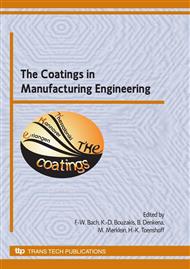p.1
p.9
p.17
p.23
p.31
p.35
Comparison of Nitride and Noble Metal Coatings for Precision Glass Molding Tools
Abstract:
The complexity of optical components increases steadily in recent years, while their dimension de-crease. This situation makes the production of state of the art optical components by grinding and polishing very difficult and expensive. However, the technology of precision glass molding can be used to replace these traditional manufacturing methods by a single step replicative process. To achieve economies of scale with precision glass molding, a long molding tool lifetime is necessary. This can only be realized by applying protective PVD coatings on the molding tool surfaces. Well known thin hard coatings like TiAlN or CrN, as well as noble metal coatings are possible candidates. However, practical testing of carious coating-glass combinations in precision glass molding machines is not feasible due to long process times that make such testing very expensive and time consuming. In this work, these coatings are compared with each other and in combination with various glass types by performing oxidation and contact angle tests. The results of these tests are compared to the results of practical tests, in order to determine to which extent such model tests can replace practical testing.
Info:
Periodical:
Pages:
9-16
Citation:
Online since:
May 2010
Authors:
Keywords:
Price:
Сopyright:
© 2010 Trans Tech Publications Ltd. All Rights Reserved
Share:
Citation:


